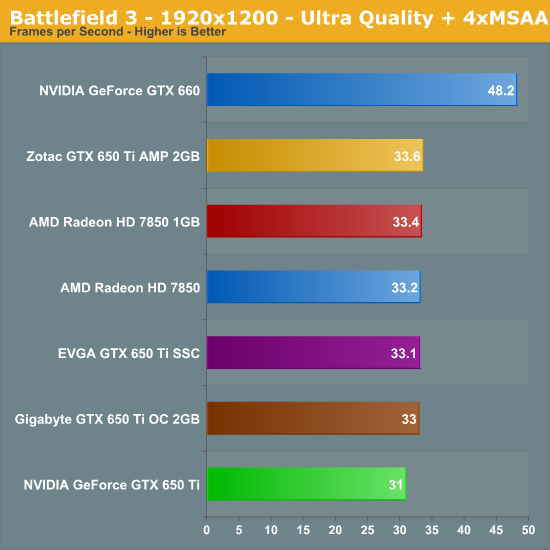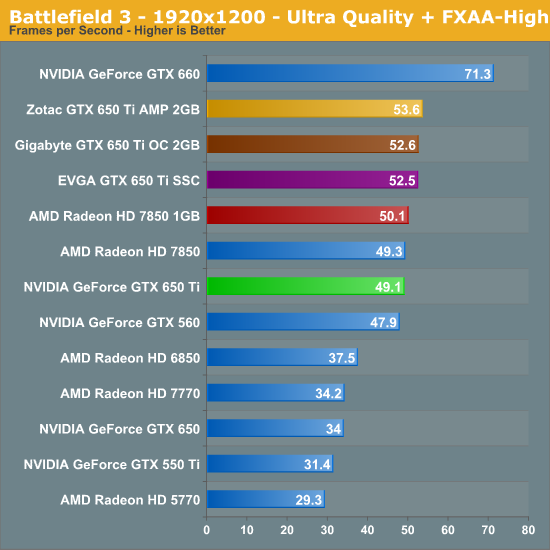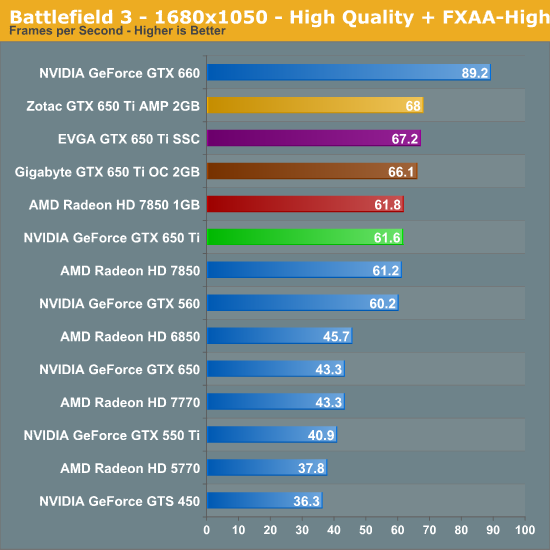The NVIDIA GeForce GTX 650 Ti Review, Feat. Gigabyte, Zotac, & EVGA
by Ryan Smith on October 9, 2012 9:00 AM ESTBattlefield 3
Its popularity aside, Battlefield 3 may be the most interesting game in our benchmark suite for a single reason: it’s the first AAA DX10+ game. It’s been 5 years since the launch of the first DX10 GPUs, and 3 whole process node shrinks later we’re finally to the point where games are using DX10’s functionality as a baseline rather than an addition. Not surprisingly BF3 is one of the best looking games in our suite, but as with past Battlefield games that beauty comes with a high performance cost.



Battlefield 3 is the game that really drives home the point that the GTX 650 Ti isn’t well suited for 1920x1200 with top quality settings. We have to get down to 1680x1050 with high quality (a notch below ultra) in order to get our framerate above 60fps, a prerequisite for keeping it from bottoming out below 30fps in large multiplayer firefights. To that end the GTX 650 Ti is fast enough (if just barely) to hit the kind of solid framerates needed for Battlefield 3.
With Battlefield 3 being another game that has typically favored NVIDIA’s architectures, the results of our benchmarks may or may not come as a great surprise. Typically NVIDIA’s cards have enjoyed 10%+ leads, but not this time. Instead the GTX 650 Ti and the 7850 are in a dead heat, posting framerates within a fraction of each other. On the other hand, given the fact that the GTX 650 Ti is being sold as a slower, lower priced card than the 7850, the fact that it can tie the 7850 here is quite remarkable. The kind of lopsided performance we’re seeing today means that the comparable AMD and NVIDIA cards aren’t going back and forth on a game-by-game basis, but it doesn’t have to be a blowout either.
Meanwhile the factory overclocked cards build upon that tie and push past the reference GTX 650 Ti and the 7850. Once more the Zotac takes the lead thanks to its combined overclock, followed by the EVGA card and finally the Gigabyte card.
On a side note, we haven’t really discussed the GeForce 500 series before now, so let’s do that. On the one hand, despite the GTX 650 Ti’s difficulties versus the 7850, one thing NVIDIA has clearly been able to do is to rocket past the GTX 550 Ti. At a year and a half old it’s not direct competition, but it shows that compared to some milder gains over past-generation cards on the high-end, NVIDIA’s mid-to-low cards are seeing greater gains. On the other hand the GTX 550 Ti was an overpriced card when it launched, so this also isn’t a ringing endorsement.
On the other hand the performance compared to the GTX 560 isn’t particularly enthusing. The GTX 650 Ti is never really passing the GTX 560 in performance, and while the GTX 560 is an outgoing card it means that at launch the GTX 650 Ti isn’t offering anything on the price/performance curve the GTX 560 wasn’t already hitting.










91 Comments
View All Comments
AbbieHoffman - Sunday, October 27, 2013 - link
Can't we all just get along?I have to admit I am a AMD fan. If it was not for AMD we would not have any competition with Intel, And we would still be paying $2,000-$3,000 grand for computers. I have a Diamond ATI 5850 which I loved. For the last 3 years it has played every game I purchased. Well one day it went out on me. (I did abuse it however) Anyway I got me a used PNY 9800 GTX+ to use untill I could buy a new card. I was impressed by the old 9800 GTX+ It was performing very well almost as good as the 5850. After that I had respect for Nvidia cards. When the time came to buy my new card I looked up 7700s from AMD and the 650-660 from Nvidia. Well the best performance for price I found was the MSI 650 TI, It was at a lower price than the AMD cards. I got the card for $114 and a $25 rebate, So $98 bucks was the final price. That was a deal I could not pass up. I am also very pleased with the 650ti's performance.
The system the card is in (below)
MSI-P55-GD65
i5 750
8GB Gskill Ripjaw 1600